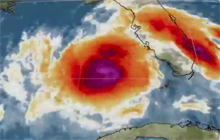The hype has begun.
I am seeing and hearing stories all over the place comparing Tropical Storm Isaac to Hurricane Katrina. And why not, given the likelihood that Isaac will make landfall near New Orleans on the seventh anniversary of Katrina’s landfall?
But these are very different storms.
Isaac may become a hurricane, but at the moment is a still disorganized tropical storm. When Katrina was where Isaac is Monday afternoon, it was already a 100 mile per hour storm. And while the Gulf of Mexico is warm now, it was even warmer seven years ago. Warm water is the fuel that storms need to grow.
Katrina was so big, hurricane force winds extended 75 miles east of the center. The Weather Channel recounts, “Katrina first hit Florida August 25 as a Category 1 storm, strengthened to a Category 5 from a Category 3 in just 12 hours over the Gulf of Mexico, then hit the Gulf Coast August 29 as a weaker but dangerous Category 3.”
A Category 1 Hurricane, which Isaac may be at landfall, is a storm with 74-95 mph winds. The National Hurricane Center describes this level storm:
Very dangerous winds will produce some damage: Well-constructed frame homes could have damage to roof, shingles, vinyl siding and gutters. Large branches of trees will snap and shallowly rooted trees may be toppled. Extensive damage to power lines and poles likely will result in power outages that could last a few to several days.
Compare that to Katrina, a Category 5 storm with winds of 157 mph or higher:
Catastrophic damage will occur: A high percentage of framed homes will be destroyed, with total roof failure and wall collapse. Fallen trees and power poles will isolate residential areas. Power outages will last for weeks to possibly months. Most of the area will be uninhabitable for weeks or months.
Using data from the National Hurricane Center, I created a map showing every hurricane and tropical storm that occurred in the Gulf of Mexico going back to 1885. As you can see, the Gulf commonly produces severe weather. You can create your own comparative tracks too.
Journalists have to get this stuff right. Katrina turned cities and lives upside down. When you compare any storm to that catastrophe, you are alarming more than you might realize.
Related: How will Times-Picayune cover tropical storms and hurricanes after it reduces print and staff?









Comments